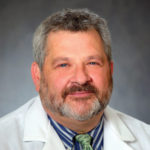Regenerative Tissue Shows Promise for Treating the Chronic Wound Epidemic

Skin substitutes can be an effective method to treat the most difficult chronic wounds, some of which can take years, if not decades, to heal. In addition to hastening healing, regenerative tissue provides an alternative to using patients’ own tissue that introduces the risk of creating a secondary wound, according to Aron Wahrman, M.D., section chief of plastic surgery at Philadelphia VA Medical Center.
“Chronic wounds are a major challenge for patients and a significant cost for society,” Wahrman says. In the United States, an estimated 5.7 million patients are affected with venous, diabetic and pressure ulcers and other chronic wounds—all of which can become infected and possibly result in amputation or death. Chronic wound patients endure severe physical pain, emotional distress, reduced mobility and social isolation. Financially, more than $20 billion a year is spent on the treatment of chronic wounds, and an additional $12 billion on the care of scars.
Human, Animal & Synthetic-based Options
Bioengineered skin substitutes for wound healing were first developed in the early 20th century. In the 1970s, cultured epidermal autografts were created from patients’ own skin cells. The first dermal substitutes hit the market in the 1980s.
Today, skin substitutes are sometimes made using cells from the inner part of the human placenta (amnion) or the outer membrane (chorion), or from neonatal foreskin. In other cases, tissue from pigs, sheep or cows is used. According to HealthTrust’s recent clinical evidence review (CER) on regenerative tissue, other promising products on the horizon include:
• Biologic skin substitutes made from animal or human tissue that are coated in antibiotics or deliver growth factors
• Synthetic skin products that get absorbed by the body
• Stem cell products
• Manipulation/application of patient’s adipose/stem cells
• Adhesives
Treatment approaches likely to grow in popularity include platelet-rich therapies using patients’ own blood to assist with healing and dermatome technologies allowing for the harvest of small autologous skin grafts.
“I’m optimistic about technologies that will take a very small piece of patients’ skin, almost biopsy size, and leverage it to create a skin culture type of substitute,” says Wahrman, a HealthTrust Physician Advisor. “There’s probably nothing better than what you’re born with. If you can do something with patients’ own tissues, alone or in combination with other elements, that’s like the holy grail.”
Despite the lack of solid scientific research, the consensus among experts is that chronic wound patients generally benefit more from human tissue products than animal-based products, according to HealthTrust’s CER.
No One-Size-Fits-All Solution

Denise Dunco, MSN, RN, former manager of physician services at HealthTrust, says there is no clear winner among the regenerative cellular products available. “They all have similar characteristics to improve the outcome of the wound. To some degree, product selection is based on patients’ comorbidities and their underlying disease. It’s a trial-and-error process,” she explains. “Doctors will try one thing and, if it doesn’t work, they’ll try another. There is not any good clinical evidence that supports what to use or when to use it.”
In Wahrman’s opinion, “Many skin substitutes are good; a lot of them have their pluses and minuses, but nothing is perfect or 100 percent successful.” He points out that some technologies need a lot of preparation, such as defrosting or soaking, but how “difficult or daunting” they’re perceived to be varies among practitioners. “They may just say, ‘I like this product so much it’s worth the extra effort.’ ”
Wahrman also notes that clinicians sometimes misuse or overuse skin substitutes.
It’s not that the products themselves fail, he says, but often the wrong product was chosen. Wahrman stresses that practicing physicians must be judicious about the products they use, practice good follow-up and select patients who will likely adhere to treatment plans. “Many patients with chronic wounds are diabetic, so they have to be compliant with their medication, their diet and, in particular, with not smoking—that’s critical,” he adds.
The CER also discusses qualities of ideal tissue-based products for chronic wounds, including the ability to resist or treat infection, induce blood flow to the wound and prevent body fluid loss. They should also have low or no antigenicity, meaning they work with, rather than against, the body’s immune system to promote healing. Additionally, tissue-based products should be compatible with other therapeutic modalities, such as vacuum-assisted closure and negative-pressure wound therapy.
Cost and Reimbursement
As with any medical product or service, clinicians need to factor cost and reimbursement into their decision-making. “What drives product selection is the cost of the product, clinic overhead and the local wage index, which is determined by the Centers for Medicare & Medicaid Services,” Dunco says. It’s also important to remember that an expensive skin substitute could provide more value than a cheaper product that is applied more frequently.
Reimbursement for skin substitutes varies widely by product type and assigned Q-code, treatment setting and local coverage decisions, but precertification is typically required.*
Most Medicare Advantage plans limit coverage to Dermagraft, an FDA-approved, bioengineered, human dermal substitute used for the treatment of diabetic foot ulcers (DFUs), and Apligraft, an FDA-approved bioengineered living cell therapy indicated for venous leg ulcers and DFUs due to blood flow insufficiency. Many private insurance plans deny coverage for other cellular and/or tissue products. “Every patient seems to be a new adventure in terms of what can or cannot get covered,” Wahrman says.
As clinicians choose which products best meet the needs and preferences of their patients, Wahrman suggests keeping these factors in mind: pain control, allergies or sensitivities, odor control, ease of use, frequency of dressing changes required, and compatibility with the activities of daily living. Finally, clinicians need to get a sense of how the patient feels about the wound and how they would respond to a scar.
Although scarring is not ideal, Wahrman is quick to point out that the aim of chronic wound treatment is healing the injury rather than restoring normal appearance. “To a patient who’s been struggling for a long time, a healed wound is the most beautiful thing in the world, even if the skin doesn’t look completely normal.”
Visit the Physician Services section of the member portal to read the clinical evidence review on regenerative tissue.
*Documentation for payment must include relevant HCPCS codes 15271–15278 and the correct Q-code when high-cost products are applied.





